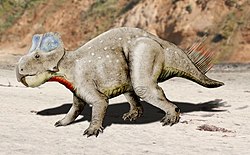Zhuchengceratops
|
Zhuchengceratops Temporal range: Upper Cretaceous, 70 Ma |
|
|---|---|
 |
|
| Life restoration | |
| Scientific classification | |
| Kingdom: | Animalia |
| Phylum: | Chordata |
| Class: | Reptilia |
| Clade: | Dinosauria |
| Order: | †Ornithischia |
| Family: | † |
| Genus: |
†Zhuchengceratops Xu et al., 2010 |
| Species: | †Z. inexpectus |
| Binomial name | |
|
Zhuchengceratops inexpectus Xu et al., 2010 |
|
Zhuchengceratops is a genus of extinct ceratopsian that lived during the Upper Cretaceous of modern-day China. It was first described in 2010, by Xu et al., who created the binomial Zhuchengceratops inexpectus. The name is derived from the location of Zhucheng, the Latinized-Greek ceratops, or "horned face", and the unexpected articulated nature of the holotype. The skeleton was found in the Wanshi Group, which is of Late Cretaceous age, and most fossils are only disarticulated bones of Shantungosaurus.
Zhuchengceratops shares may features with Leptoceratopsidae as well as other ceratopsian groups such as Ceratopsidae. The overall size of the taxon was similar to , although slightly larger. Zhuchengceratops was analyzed to be in a group with Leptoceratops and Udanoceratops, although internal relationships of this triplet were unresolved.
Zhuchengceratops is a derived ceratopsian which lived during the Late Cretaceous period in what is now Kugou, Zhucheng County, China. It is known from a partial articulated skeleton including vertebrae, ribs, teeth, and parts of the skull and mandibles. The fossils were recovered from the Wangshi Group, of the Late Cretaceous. This genus was named by Xing Xu, Kebai Wang, Xijin Zhao, Corwin Sullivan and Shuqing Chen in 2010, and the type species is Zhuchengceratops inexpectus. The genus name was chosen for the location of Zhucheng, where the holotype was found, and the Latinized-Greek ceraptops, meaning "horned face". They chose the species name inexpectus to refer to the unexpected discovery of the articulated skeleton.
...
Wikipedia
